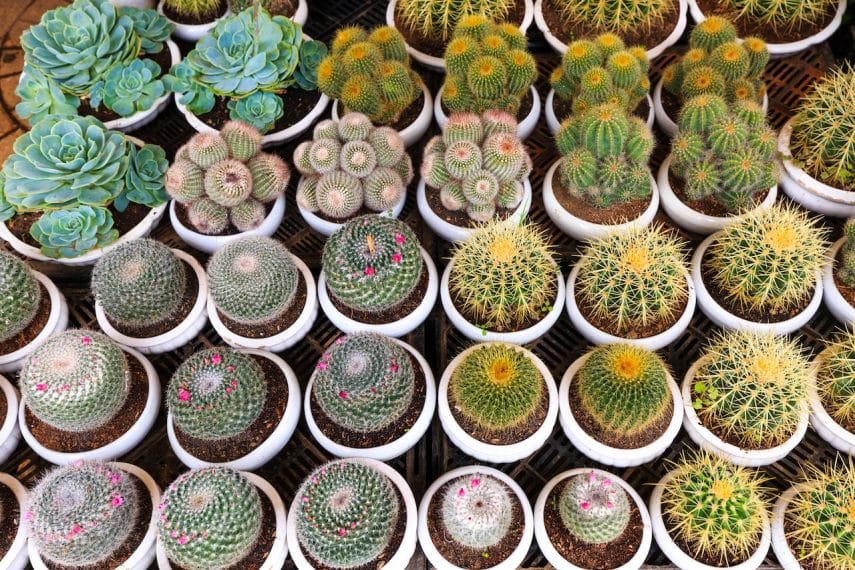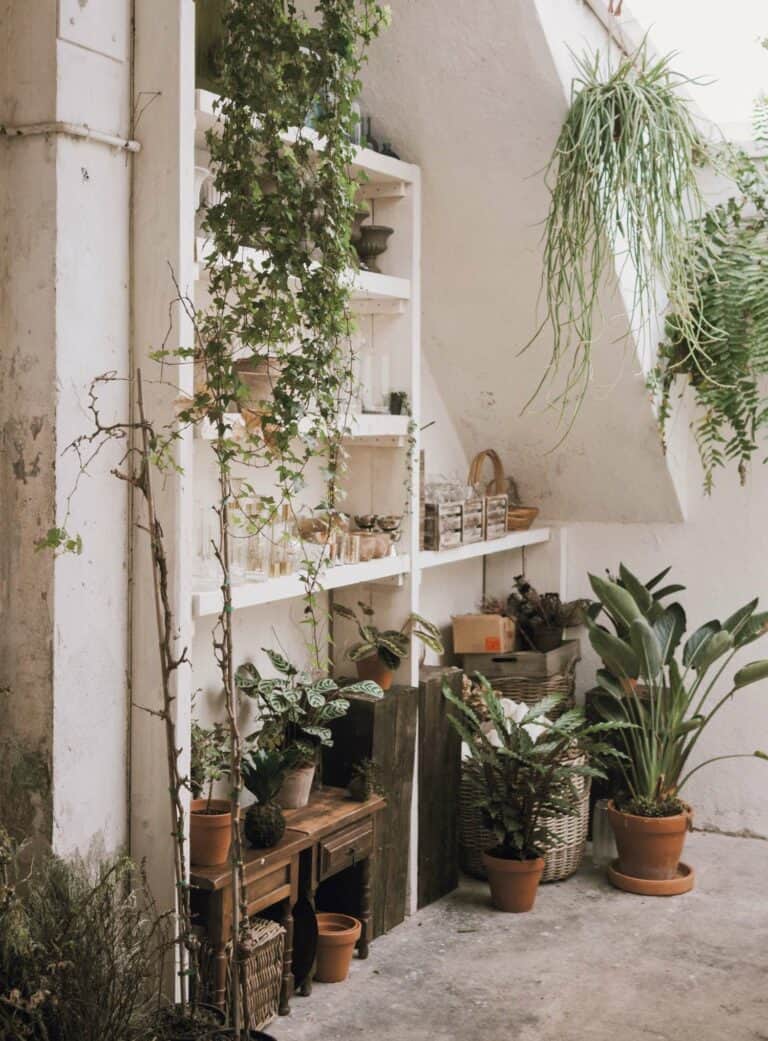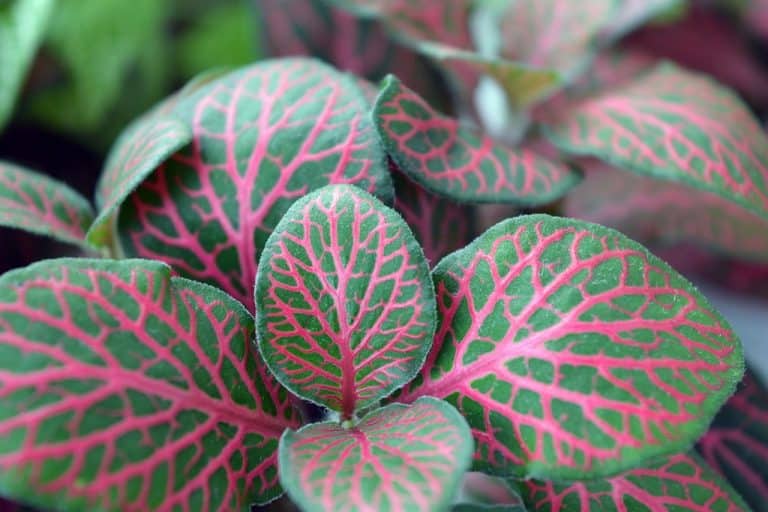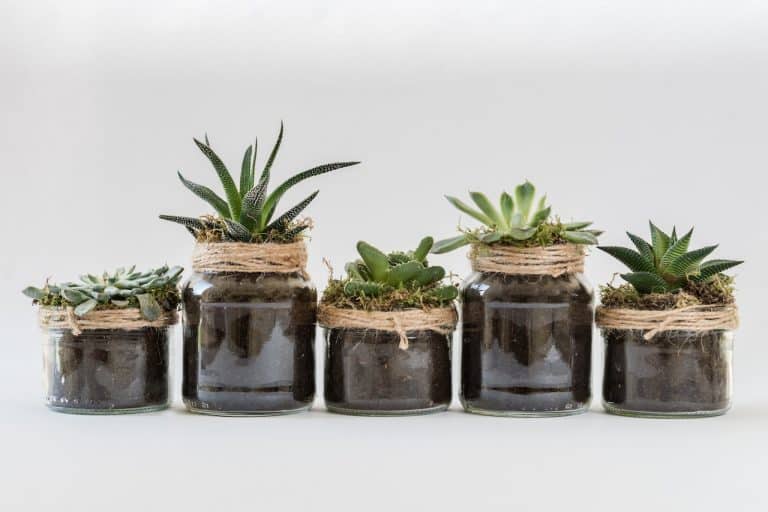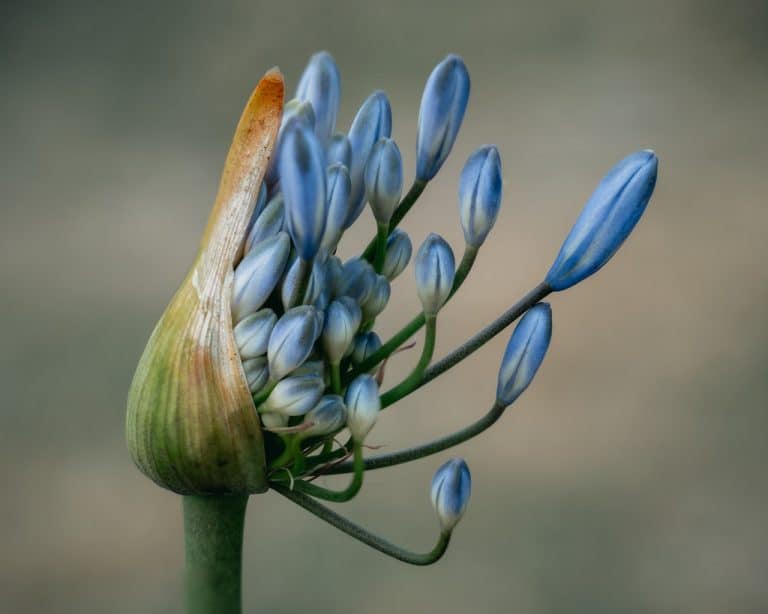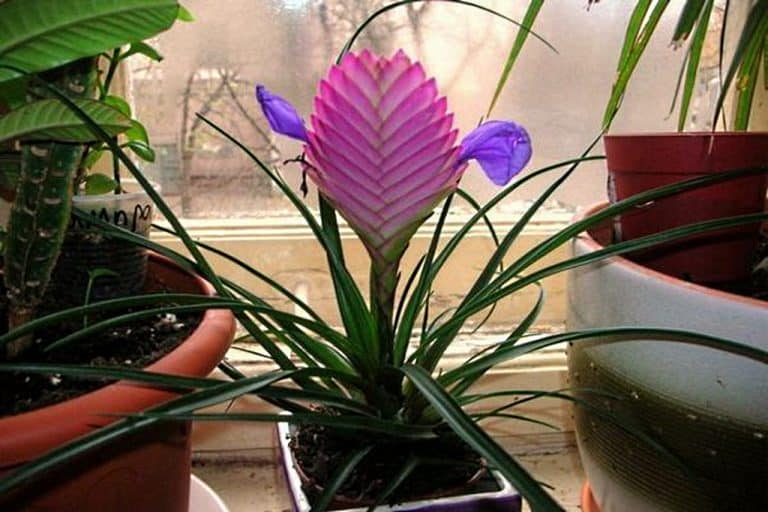Top 9 Popular And Easy To Grow Cacti Species
To help make plant identification simple, cacti and succulents are sorted into groups.
Remember:
- Cacti have spines, while succulents seldom do.
- Succulents also have leaves, which are absent in cacti.
FAMILY: CACTACEAE ORIGIN: MEXICO
RAT’S TAIL CACTUS
A FAST GROWER, the stems of rat’s tail cactus can lengthen by 3 in/7.5 cm or more each year, eventually growing to 4 ft/1.2 m long. Showy flowers appear in spring and early summer.
Though the flowers last only a few days, new ones continue to open for several weeks. They are most numerous on the previous year’s growth.
A natural creeper adapted to growing in rocky ledges and trees, rat’s tail cactus develops little roots along the stems, making it easy to propagate.
Stems of the original species have very shallow ridges, but numerous hybrids have dark green, deeply ridged stems.
These large-flowered hybrids are less demanding of bright light and produce very large flowers in unusual colors including purple, pink, and bright orange. The ancestral species blooms violet-red.
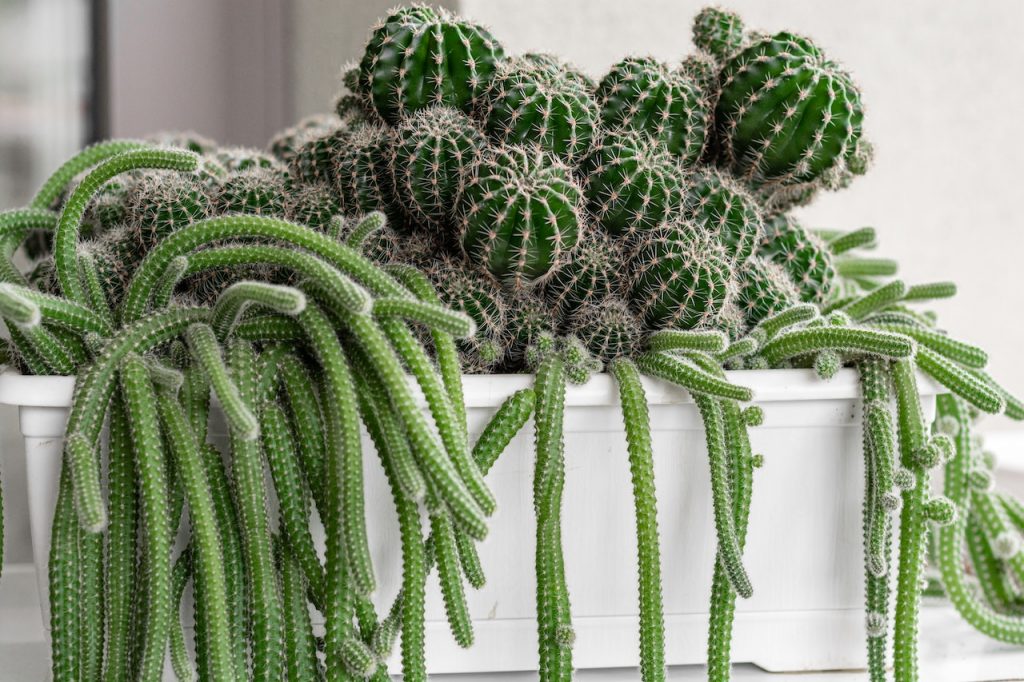
SPECIFICATIONS
Light: In spring and summer, bright, or move to a half-shaded place outdoors. In fall and winter, bright light increases flowering in spring.
Temperature: In spring and summer, average room temperatures (65–75°F/18–24°C). In fall and winter, quite cool (50–55°F/10–13°C).
Fertilizer: Begin feeding in late winter with a cactus fertilizer or high-phosphorous fertilizer mixed at half the normal strength. Continue regular light feeding until late summer. Do not feed in fall and early winter.
Water: In spring to midsummer, water thoroughly, allowing soil to almost dry between waterings. In fall and winter, water less frequently, but do not allow soil to dry out completely. Dry stem tips are a symptom of insufficient water.
Soil: Cactus potting soil, or regular potting soil amended with sand.
Repotting: Repot young plants each year in midsummer. Older plants can be repotted less often.
Longevity: Many years if propagated from stem cuttings.
Propagation: Take 6 in/15 cm-long stem cuttings in early summer, allow the cut ends to dry for 2 days, and then set them to root in damp potting soil.
Selections: Buy plants in bloom if you want a certain color.
Display tips: This plant is most spectacular when grown in a hanging basket. The short spines are sharp and treacherous, so keep the plant well away from activity areas.
FAMILY: CACTACEAE ORIGIN: BRAZIL, URUGUAY, ARGENTINA
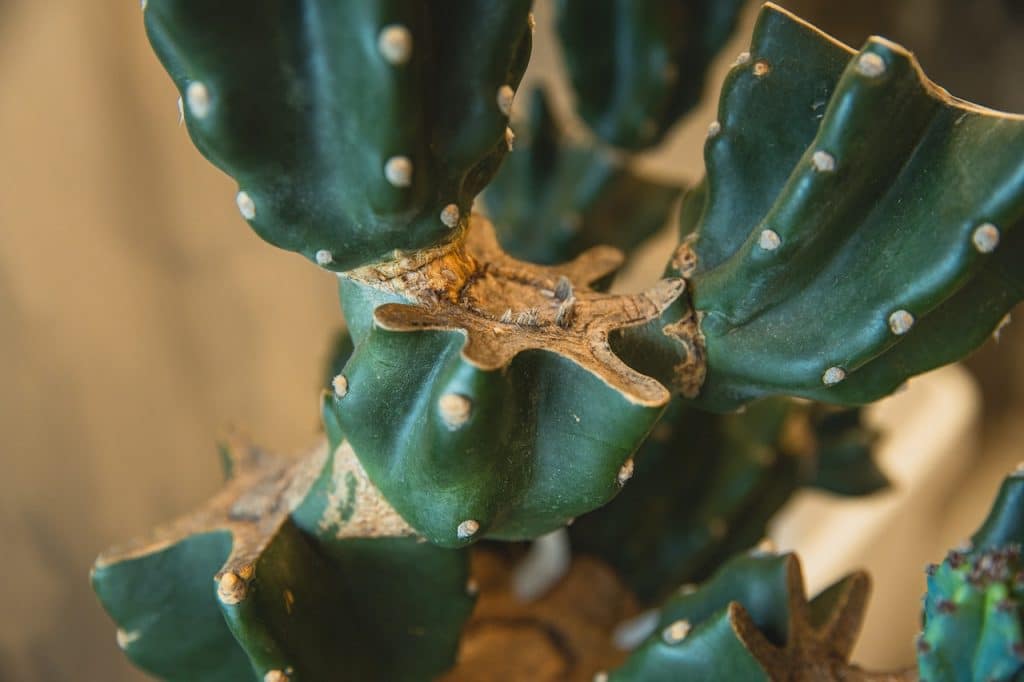
PERUVIAN APPLE CACTUS, COLUMN CACTUS, PERUVIAN TORCH
CEREUS CACTI OF THIS SPECIES include two very different forms often grown as houseplants. Most common are tall, columnar specimens, which are the mysterious night-blooming cereus.
Only very old specimens bloom, but when they do the show is spectacular. Large white flowers to 6 in/15 cm long open at night and close the next morning.
In the wild, the flowers give rise to edible red fruits that resemble apples. When kept as houseplants, these cacti are best appreciated for their upright form.
They like to be moved outdoors in summer, an operation that must be undertaken carefully since the plants are quite heavy and well armored with tiny spines.
A subspecies with a remarkably globular, convoluted form, Cereus peruvianus monstrosus stays smaller, growing to less than 24 in/60 cm tall. This is an excellent cactus for beginners.
It seldom blooms, though very old plants may occasionally produce short-lived white flowers in summer. This clublike cactus resembles a green sculpture, and it is very long lived and dependable. Some forms are much more attractive than others.
SPECIFICATIONS
Light: From late spring to early fall, bright; consider moving plant outdoors into dappled sun. In winter, bright light from a south or west window.
Temperature: From late spring to early fall, warm (70–80°F/21–27°C). In winter, cool (50–65°F/10–18°C).
Fertilizer: From spring through fall, feed monthly with a balanced houseplant fertilizer. In winter, do not feed.
Water: Allow soil to become almost dry between waterings. The plant should become slightly spongy, then plump up noticeably after watering.
Soil: 3 parts cactus potting soil to 1 part sterilized garden soil (the garden soil gives the medium a slightly heavy texture).
Repotting: Repot young plants every 2 years in spring. Older plants may be repotted only every few years.
Longevity: 20 years or more.
Propagation: Cuttings root easily.
Selections: With the columnar form, look for pots in which three plants have been established as a group. Among C. p. monstrosus selections, the ‘Ming Thing Blue’ cultivar features exotic swirled lobes in a blue-green jade color. Its sculptural quality is awesome.
Display tips: Columnar types are prone to toppling and have sharp spines, so give them a wide berth in high-traffic areas. Use ‘Ming Thing’ or other attractive selections as focal-point plants in groupings of cactus or other succulents.
FAMILY: CACTACEAE ORIGIN: SOUTH AMERICA
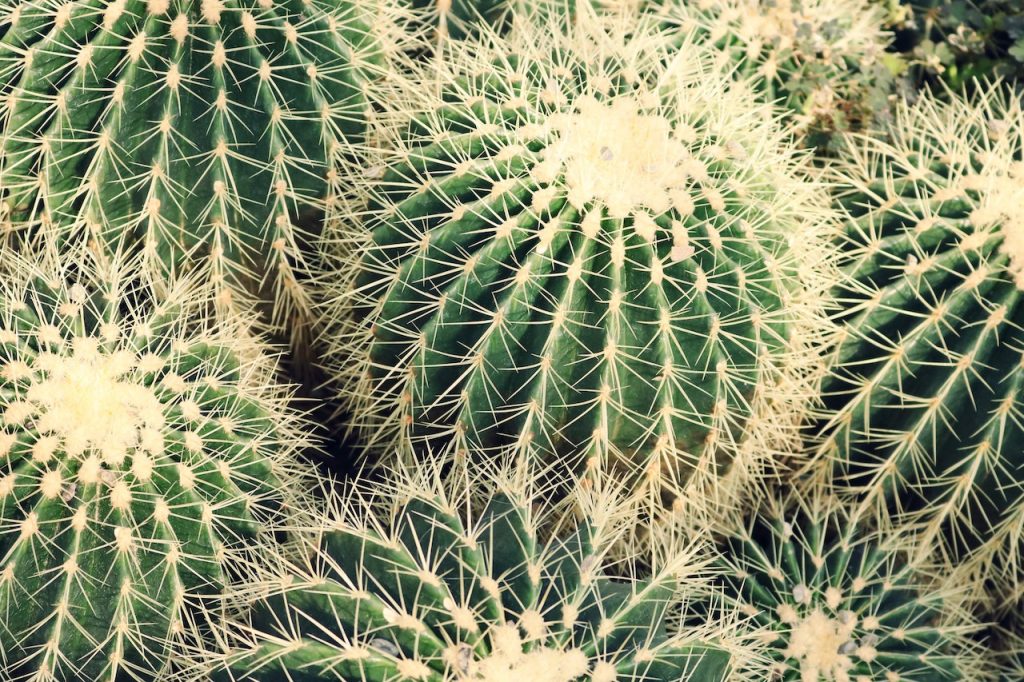
SEA URCHIN CACTUS, PEANUT CACTUS
THE SEA URCHIN CACTUS lives up to its name by developing huge flowers on tubular stems, which emerge in clusters from the round cactus bodies in summer.
Many species are similar, and some bloom only at night. Named hybrids that have been developed for strong flower production often bloom two or three times in the summer provided they enjoy a cool, dry rest period in the winter.
There are hundreds of other species within the Echinopsis genus, which now includes cacti that were long known under other names, including Lobivia and Trichocerus.
All share a need for cool, dry winters and a tendency to bloom at night. Some common “peanut” cacti are included in this group, and they are very easy to grow.
To promote strong blooming, feed them regularly through summer and keep them cool through winter so they can set flower buds.
SPECIFICATIONS
Light: From late spring to early fall, a half-shaded spot outdoors. In winter, bright light near a south or west window.
Temperature: From late spring to early fall, warm (70–80°F/21–27°C). In winter, cool (55–65°F/13–18°C).
Fertilizer: In spring and summer, feed plants monthly with a balanced fertilizer. In late fall and winter, do not feed.
Water: In spring and summer, water more often than other cacti, allowing soil to almost dry between waterings. In late fall and winter, keep plants very dry. Mist occasionally during winter rest period.
Soil: Cactus soil, or potting soil amended with sand.
Repotting: Repot when plants need more space, preferably in summer after flowers have faded. Pot up offsets after they grow to more than 1 in/2.5 cm in diameter.
Longevity: Many years if offsets are rooted every 3 to 4 years.
Propagation: Offsets; seeds.
Selections: The many named varieties vary in flower size and color. Orange-flowered ‘Paramount’ is a common parent, yet there are at least a dozen more available, some with contrasting midribs. All are beautiful.
Display tips: One of these cacti in full bloom forms a bouquet of exotic blossoms, which makes an awesome table centerpiece.
FAMILY: CACTACEAE ORIGIN: SOUTH AMERICA
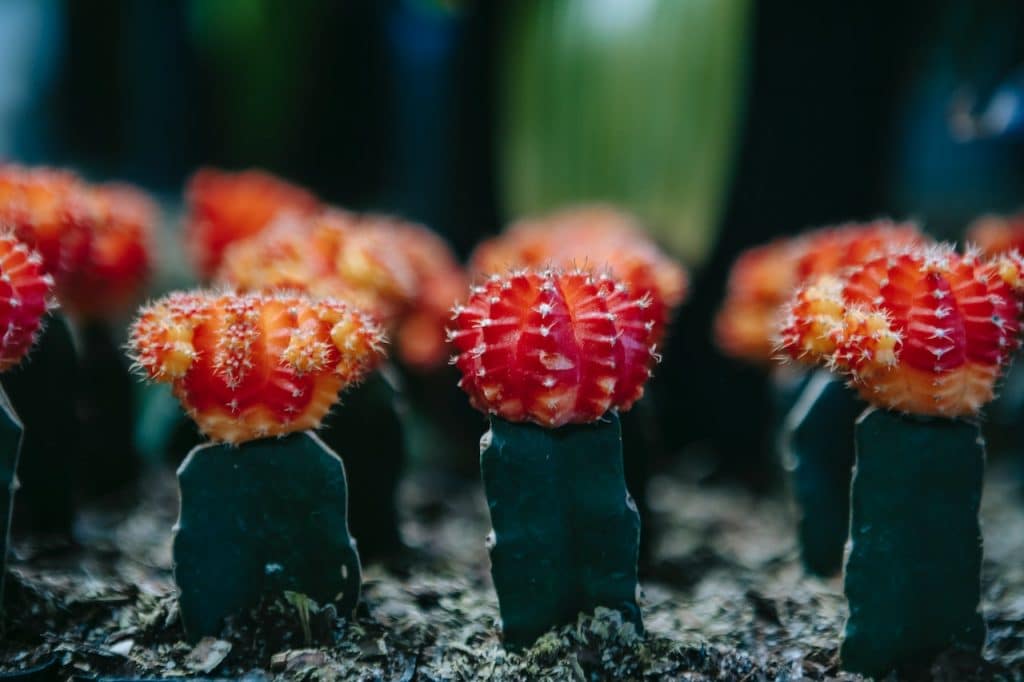
THIS ATTENTION-GETTING CACTUS is really two cacti in one. The red top, a mutant form of Gymnocalycium that lacks chlorophyll but features bright red, orange, yellow, or pink color, is grafted onto a more vigorous green cactus.
The green cactus feeds itself and the grafted top, and both gradually grow larger. After several years, red top may produce pink flowers in summer, provided the plant gets a cool rest in winter.
Old, well-pleased plants also develop round offsets just above the graft union. The trickiest part of growing this cactus is getting the light right.
The colorful cap can burn in bright sun, but the green part needs bright light in order to photosynthesize light energy for the whole plant.
SPECIFICATIONS
Light: Bright light but not direct sun year round.
Temperature: From spring through fall, warm (70–80°F/21–27°C). In winter, move to a cooler spot (50–60°F/10–16°C).
Fertilizer: In spring and summer, fertilize monthly with a balanced liquid plant food mixed at half the recommended rate. In fall and winter, do not feed.
Water: Allow soil to become nearly dry between waterings, but not so dry that the cactus becomes spongy. Reduce water in winter, but do not let the soil dry out completely.
Soil: Cactus potting soil, or regular potting soil amended with a little sand.
Repotting: Repot every 1 to 2 years to accommodate growing roots and refresh the soil.
Longevity: 5 to 10 years, or sometimes longer.
Propagation: Offsets that form on older plants can be grafted onto various green cacti, but they will not root and grow on their own.
Selections: These cacti are often sold unlabeled, so simply choose a plant that appeals to you. The green rootstock may be a round ball cactus or a more upright column. Both parts will grow larger with time.
Display tips: One little red top makes a good focal point in a dish garden planted in a southwestern-style bowl. As the cactus grows, plant it in its own pot and rear it as a specimen plant for your kitchen windowsill.
FAMILY: CACTACEAE ORIGIN: BRAZIL
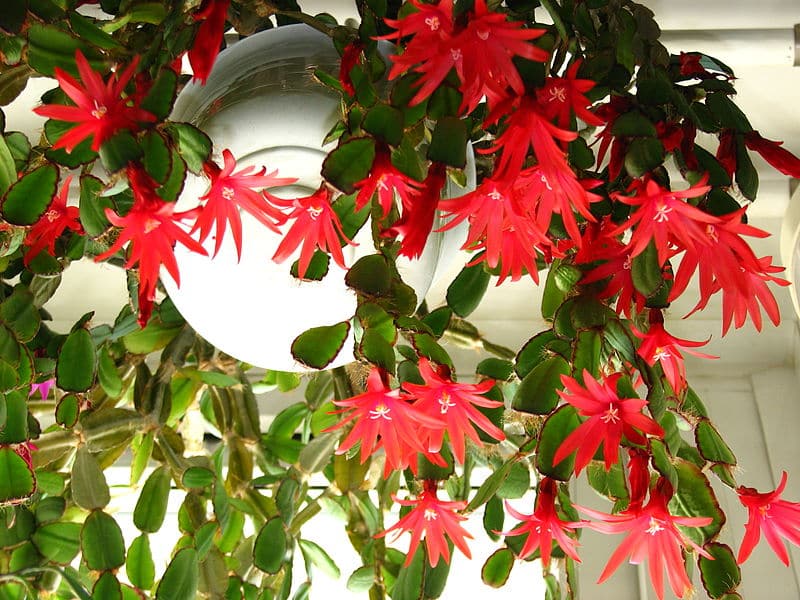
EASTER CACTUS LOOKS VERY MUCH like the more popular Christmas cactus, but it blooms in spring rather than winter. A rain forest native, it adapts to less light than other cacti, and needs more water.
Unlike Christmas cactus, this species is easily stressed by cool temperatures and should be brought indoors in early fall and kept in a bright room through winter.
Allow it a cool, dry rest period after flowering stops in late spring, but otherwise treat Easter cactus like most of your foliage houseplants.
Easter cactus is notorious for shedding its buds if it is moved during its flowering period. Locate the plant in a spot where it can stay put from late winter to late spring.
SPECIFICATIONS
Light: In summer, bright. In spring, fall, and winter, filtered indoor light.
Temperature: In summer, warm (70–80°F/21–27°C). In spring, fall, and winter, average room temperature (65–75°F/18–24°C).
Fertilizer: From early summer through fall, feed every 2 weeks with a cactus fertilizer, or a high-phosphorous fertilizer mixed at half the normal strength. In winter and spring, feed monthly.
Water: In spring, allow plants to dry out for a month after flowers fade. Through summer and early fall, keep soil lightly moist. In winter, allow soil to almost dry out between modest waterings. Shriveled stems indicate too little water.
Soil: Any good potting soil.
Repotting: Repot young plants annually in early summer. Older plants may be repotted every 2 to 3 years.
Longevity: To 6 years, or indefinitely when propagated from stem cuttings.
Propagation: Take stem cuttings consisting of two to three pads in summer, allow the cut ends to dry for a day, and then plant in moist potting soil. Keep in a shady place until new growth appears.
Selections: Buy plants in bloom to be sure of getting the color you want. Various shades of orange and pink are available.
Display tips: Grow in a hanging basket that can be suspended at eye level. Or, plant in a ceramic pot in a spring pastel color that coordinates nicely with the color of the blooms.
FAMILY: CACTACEAE ORIGIN: PRIMARILY MEXICO
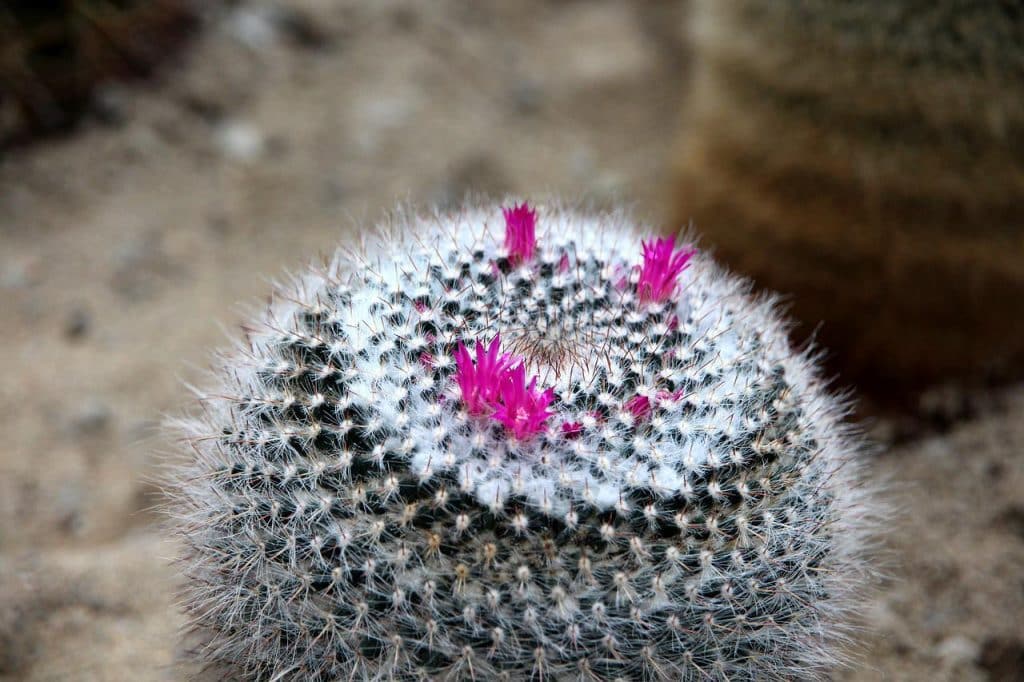
POWDER PUFF, SNOWBALL, GOLDEN STAR, LADY FINGERS, MANY OTHERS
THIS HUGE GENUS INCLUDES more than 250 species, which are often called “mamms” by devoted collectors. They are easy cacti for beginners, and so small that they work well in dish gardens.
With mammillarias, the biggest problem may be identifying what you have, since species vary in shape and appearance. All are small, rarely growing more than 8 in/20 cm tall or wide, and they lack ribs.
Instead, tufts of spines emerge from raised knobs, called tubercules, which are arranged in symmetrical patterns and are densely crowded near the crown.
Mammillarias flower at a young age, and the flowers, which are borne from creases between the tubercules, usually appear in a circular, wreathlike pattern.
To encourage blooms, which appear in late spring or summer, keep plants cooler in winter than in summer. Most species are hardy to 32°F/0°C, but it’s best to keep them above 50°F/10°C.
Dry winter conditions help flower buds to form. These cacti enjoy warm temperatures in summer, though they should be kept in a spot where strong summer sun is limited to 4 hours each day.
SPECIFICATIONS
Light: Direct sun 4 hours daily, or bright light all day, year-round.
Temperature: From late spring to early fall, warm (70–85°F/21–29°C). In winter, cool (50–65°F/10–18°C).
Fertilizer: In spring and summer, feed monthly with a cactus fertilizer, or a high-phosphorous plant food mixed at half the normal strength. In fall and winter, do not feed.
Water: Allow soil to become almost dry between waterings. In hot summer weather, plants may need water twice weekly. Water very sparingly in winter.
Soil: Cactus soil, or potting soil amended with one-third sand.
Repotting: When grown in broad, shallow containers or dish gardens, plants need repotting only every 2 to 3 years.
Longevity: Many years.
Propagation: Offsets; seeds.
Selections: Puffy white hairs cover the ball-shaped powder puff or snowball cactus (M. bocasana). Golden star or lady fingers (M. elongata) is fast and easy to grow. Many other species are available.
Display tips: Grow in shallow containers weighted with gravel in the bottom. Mammillarias are wonderful subjects for indoor window boxes that include a variety of small cacti.
FAMILY: CACTACEAE ORIGIN: SOUTH AMERICA
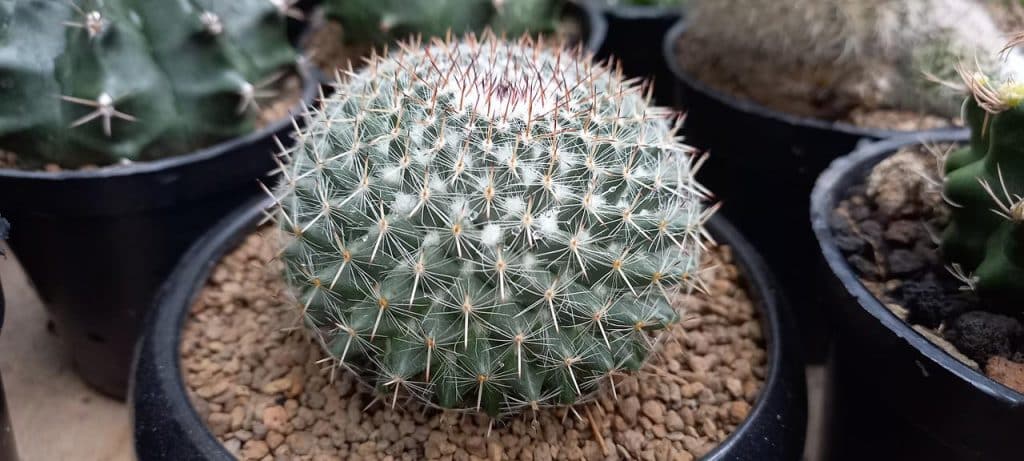
BALL CACTUS, SILVER BALL, YELLOW TOWER, TOM THUMB CACTUS
FOR 60 YEARS, THESE SHOWY LITTLE GLOBES were called Notocactus, and many catalogs (and plant tags) still use that genus name.
Now renamed Parodias, there are 100 species, several of which make excellent houseplants. Old favorites like silver ball cactus (P. scopa) are easy to grow, bloom willingly, and adapt well to life in homes and offices.
Most parodias are round and ribbed, grow to less than 10 in/25 cm tall, and often feature showy spines arranged in a symmetrical matrix pattern.
After several years, some ball cacti produce small offsets near the base. Flowers appear near the crown, and may be yellow, orange, pink, or red, depending on the species.
In their native habitat, parodias receive warm rain often in summer and experience dry, temperate winters. If you mimic this pattern, your parodias should do well. Ball cacti thrive when allowed to spend the summer outdoors in a half-shaded spot.
SPECIFICATIONS
Light: From late spring to early fall, partial shade outdoors. In winter, bright light from a south or west window.
Temperature: From late spring to early fall, warm (65–85°F/18–29°C). In winter, cool (55–65°F/13–18°C).
Fertilizer: From late spring to late summer, feed monthly with a balanced liquid fertilizer. In fall and winter, do not feed.
Water: From late spring to early fall, water as often as needed to keep soil lightly moist. In winter, allow soil to become almost dry between waterings.
Soil: A very sandy yet humus-rich mix, such as cactus soil amended with a small amount of sand.
Repotting: Repot only when the plants reach the edge of the pots, usually only every 2 to 3 years.
Longevity: Many years.
Propagation: Seeds; offsets.
Selections: Silver ball cactus (P. scopa) is widely available and easy to grow. It features showy white hairs in tufts at the spines, and yellow to yellow-orange flowers.
Yellow tower cactus (P. leninghausii) elongates as it grows, and is well armed with long yellow spines. Fast-growing Tom Thumb cactus (P. mammulosa) has a barrel shape, and often blooms repeatedly in summer.
Display tips: Place ball cactus on a low table where the patterns formed by ribs and spines can be easily seen. Combine young plants with other cacti and succulents in small dish gardens.
FAMILY: CACTACEAE ORIGIN: ARGENTINA
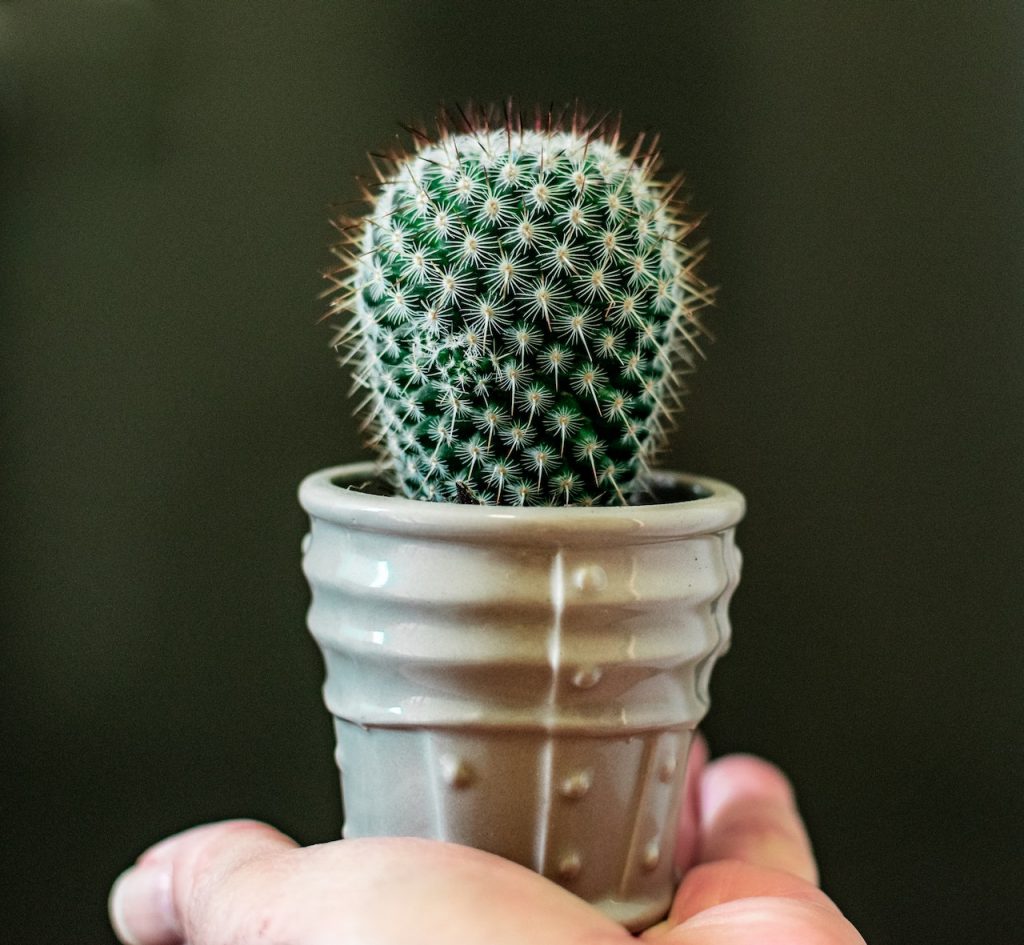
NATIVE TO HIGH ELEVATIONS of the South American Andes, these small cacti bloom willingly in spring and summer provided they are given a cool, 3-month-long winter rest.
Flower buds develop near the base of the plant or in crevices between the mother plant and its offsets. Plants with many offsets may produce a dozen tubular blossoms, which may be white, pink, yellow, orange, or red, depending on the species.
Rebutias may be sold as individual plants or included in dish gardens. Once a plant grows into a flattened head about 2.5 in/6.25 cm across and 1.5 in/3.75 cm tall, it begins propagating itself into a cluster.
With good care, a clump up to 6 in/15 cm across will develop within 3 to 4 years. In summer, carefully remove offsets with a gentle twist and transplant them to individual containers or a new dish garden.
SPECIFICATIONS
Light: From spring through fall, bright light. In winter, rest in moderate light.
Temperature: From spring through fall, average room temperature (65–75°F/18–24°C). In winter, rest in a cool room (50–65°F/10–18°C).
Fertilizer: Feed once in spring, and a second time in late summer, with a balanced liquid plant food.
Water: From spring through fall, allow soil to become nearly dry between waterings, but do water regularly. In winter, water lightly only every 7 to 10 days.
Soil: Cactus potting soil, or regular potting soil amended with grit or sand.
Repotting: Every other summer, or as needed to provide room for new offsets.
Longevity: Many years due to ease of propagation. Discard old plants when they lose color and lack vigor, which is often due to root rot.
Propagation: Offsets; seeds.
Selections: These cacti may be labeled by species name, or you may get a mystery rebutia in a dish garden. Of more than 40 species grown by collectors, the redblooming R. minuscula is famous for producing large red flowers at a young age.
Display tips: Individual plants look great in a dish garden, but a large cluster, set in a shallow pot, becomes spellbinding when it is in bloom. In good years, blooms of some species are so numerous that they nearly cover the plants.
FAMILY: CACTACEAE ORIGIN: BRAZIL
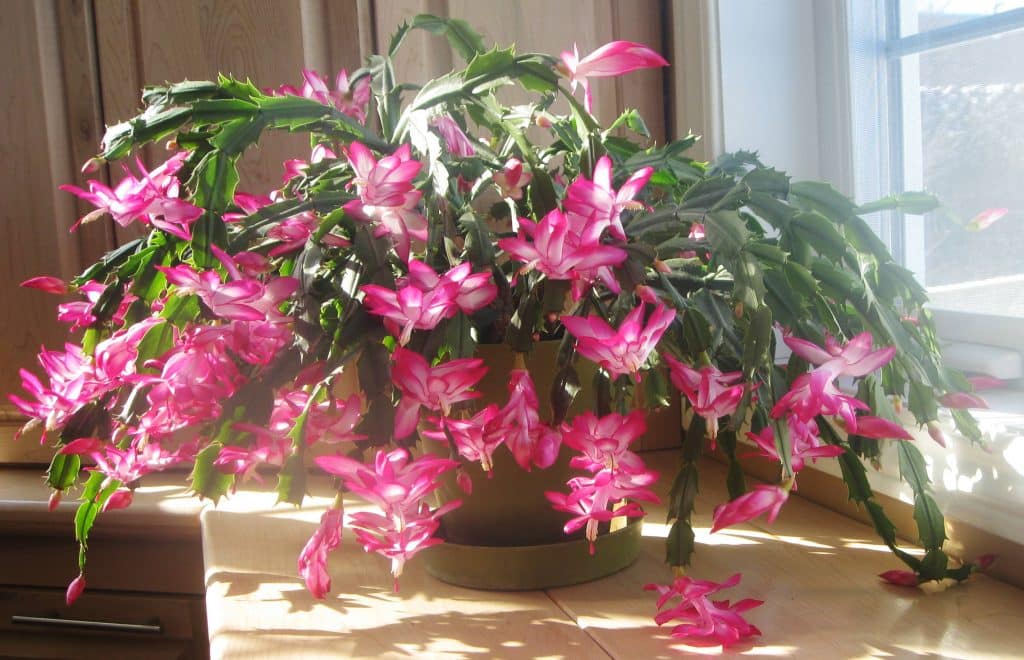
CHRISTMAS CACTUS, THANKSGIVING CACTUS, HOLIDAY CACTUS
THESE HEAVY-BLOOMING RAIN FOREST NATIVES are easy to grow, and they are available in a huge range of colors.
The intensity of bloom depends on climactic factors: bright light in summer and fall, combined with days that gradually become shorter and cooler.
It is therefore ideal to move plants outdoors in summer, and keep them there until night temperatures dip down to 40–50°F/4–10°C. When you bring them in, keep them in a cool room that stays completely dark after sunset.
Buds will develop in early winter, at which time plants should be moved to where you want them to bloom. Once plants begin blooming, they may drop their blossoms if exposed to any type of stress.
This is why plants that are bought in bloom often shed their buds and blossoms. With less shifting about after buds form, plants that shed their buds one winter will bloom beautifully the following year.
SPECIFICATIONS
Light: From late spring to fall, bright. From late winter to early spring, rest in moderate light.
Temperature: From late spring to late summer, warm (65–80°F/18–27°C). In fall and winter, cool (50–65°F/10–18°C).
Fertilizer: From spring through summer, feed every 2 weeks with a balanced fertilizer, mixed at a slightly reduced rate, or use a high-phosphorous plant food. In fall and winter, feed monthly.
Water: From spring through fall, keep soil lightly moist. In winter, allow soil to almost dry out between modest waterings. Shriveled stems indicate too little water.
Soil: Any good potting soil.
Repotting: Repot young plants annually in early summer. Older plants may be repotted every 2 to 3 years.
Longevity: 5 to 6 years, or indefinitely when propagated from stem cuttings.
Propagation: Take stem cuttings consisting of two to three pads in early summer, allow the cut ends to dry for a day, and then plant in moist potting soil. Keep in a shady place until new growth appears.
Selections: Buy plants in bloom to be sure of getting the color you want. Light pink and lilac shades are especially beautiful.
Display tips: Grow this cactus in a broad pot that can be placed on a tabletop when it blooms. Christmas cacti also are easy to grow in hanging baskets.

